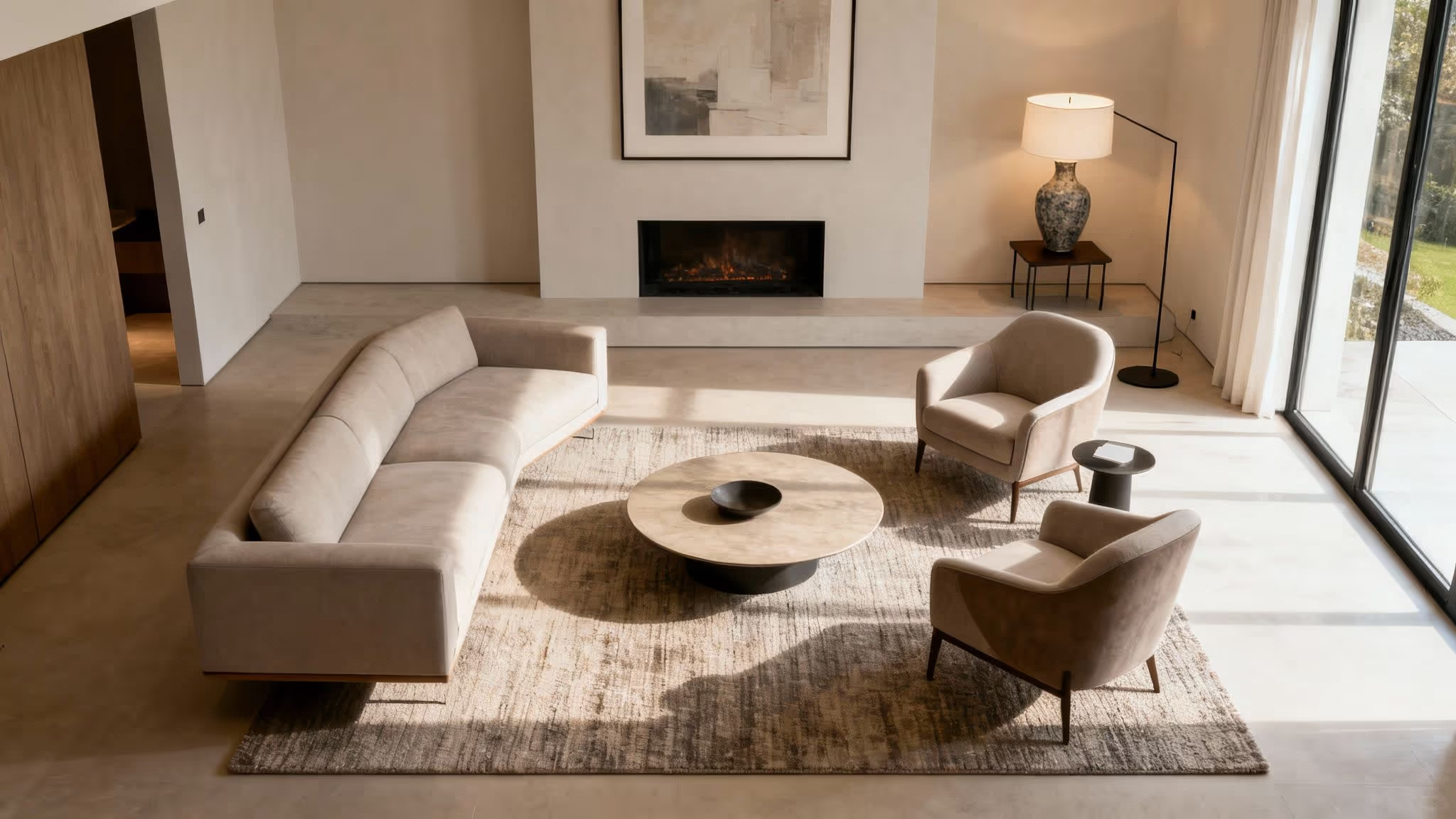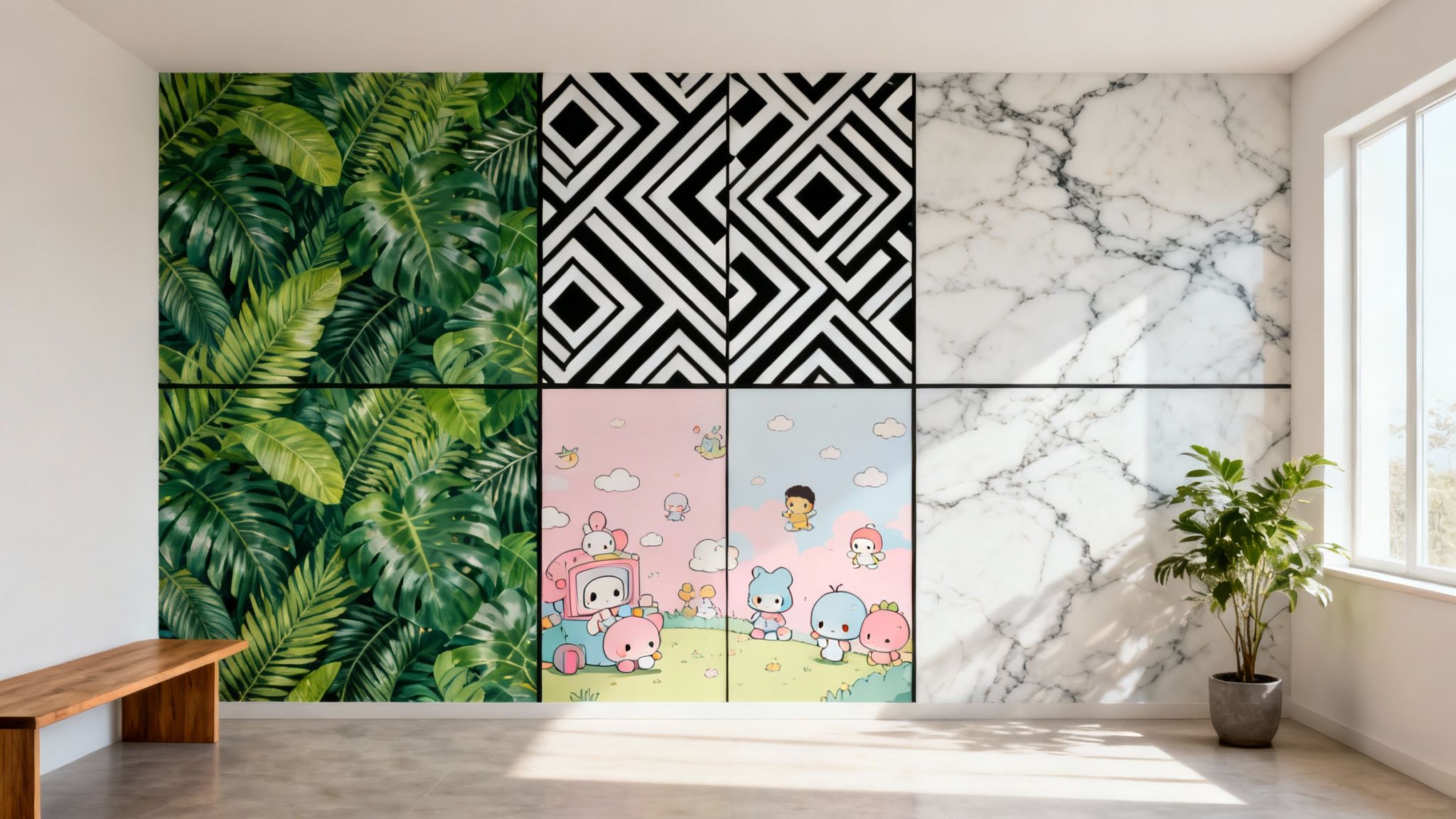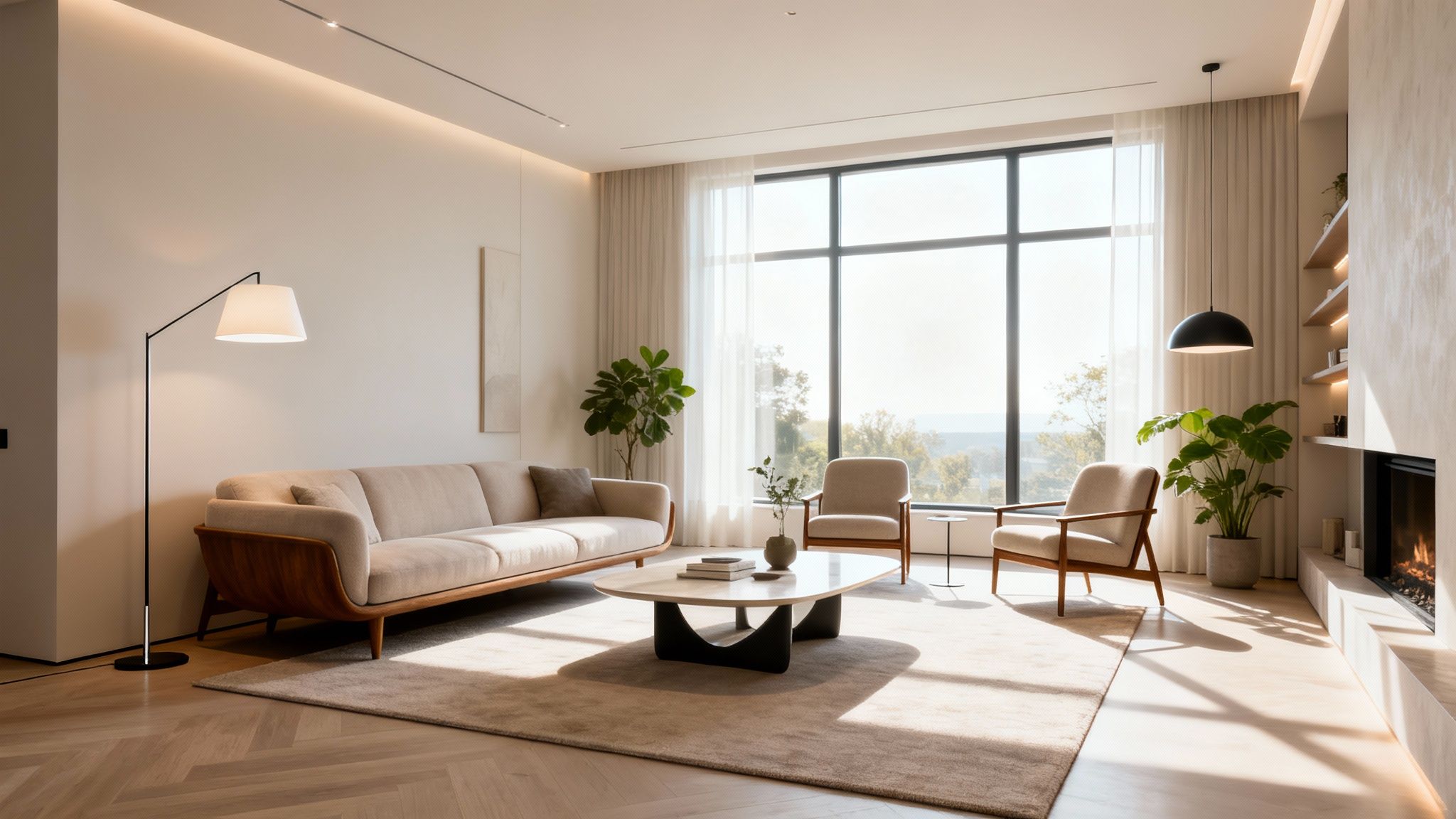Before you even think about moving a single piece of furniture, the secret to a beautifully arranged living room lies in a bit of upfront planning. It’s a simple three-part process: measure your space, decide on a focal point, and then carve out clear pathways for people to walk. Getting this right from the start saves you a lot of heavy lifting and ensures the final layout is as practical as it is stylish.
6 Steps to a Perfectly Arranged Living Room
A well-designed living room should feel effortless and intuitive. It's not just about looking good; it's about creating a space that works for your everyday life. Think of this initial planning stage as drawing a blueprint for comfort and ease.
This is where you prevent the all-too-common headache of endlessly shuffling furniture, only to feel like nothing quite clicks. A few moments spent planning will help you avoid blocked doorways, awkward dead space, and a room that just feels 'off'.
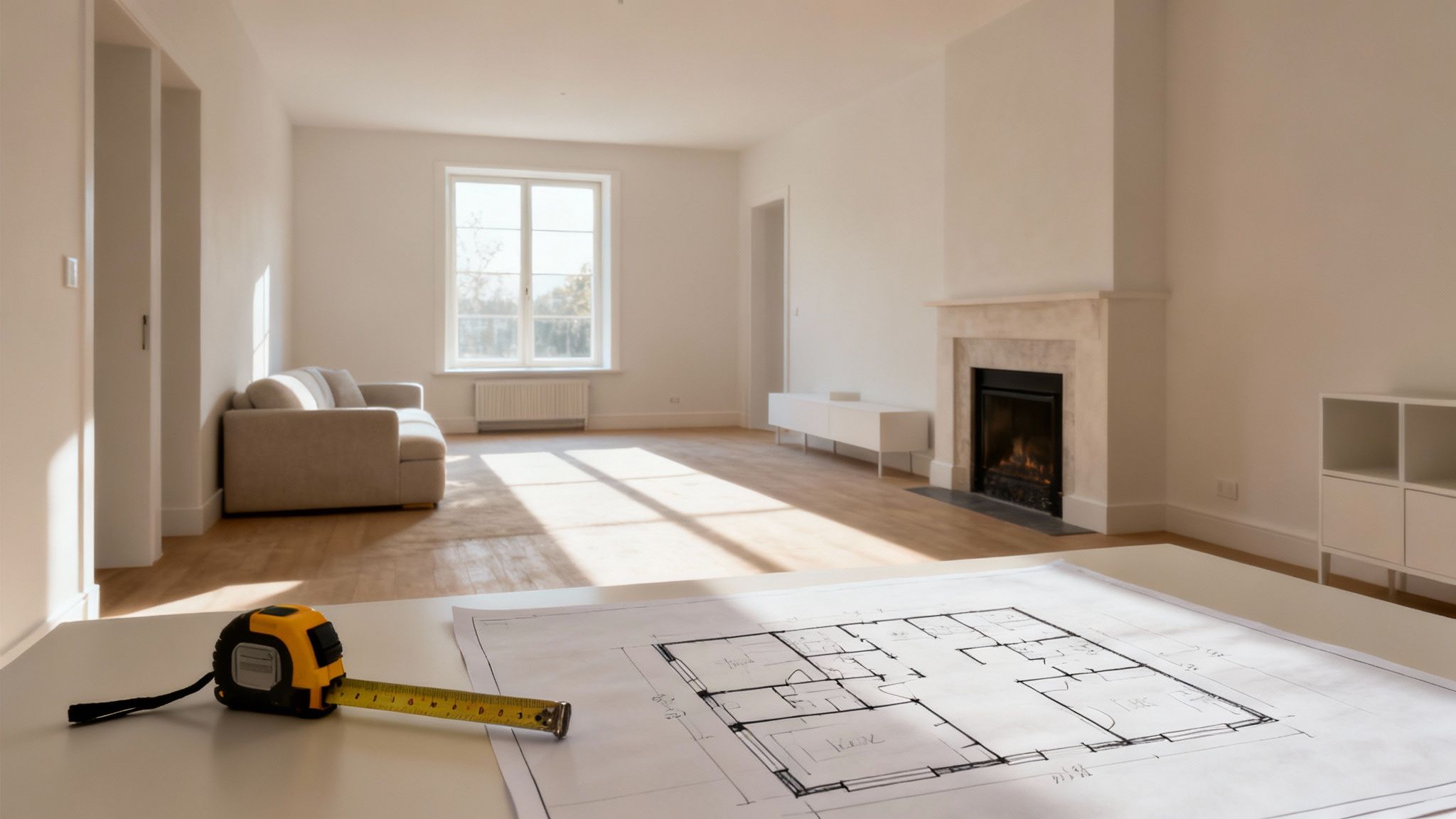
1. Define Your Focal Point
First things first, what's the star of the show? Every room has a natural focal point—the spot your eyes are instinctively drawn to when you walk in. Don't fight it; work with it.
Common focal points include:
- A classic fireplace and mantelpiece
- A large window with a killer view
- A built-in media unit or impressive bookcase
- A significant piece of art
Your focal point is the anchor for your entire layout. By arranging your main seating around it, you create a setup that feels intentional and harmonious right from the get-go.
2. Map Out Traffic Flow
Next, consider how you and your family actually move through the room. Where are the doorways? How do you get from the sofa to the kitchen? These are your traffic paths, and they need to be kept clear.
A good rule of thumb is to leave at least 90cm (about 3 feet) of space for main walkways. This ensures no one has to awkwardly shuffle past furniture and the room feels open and accessible, not like an obstacle course.
This is especially critical in modern homes. With over 60% of new-builds in the UK now designed with open-plan layouts, creating distinct zones that flow together is a real art. This trend has naturally driven a huge demand for versatile furniture that can support both quiet nights in and lively get-togethers.
Setting the stage with a focus on flow and function is the key to a living room you’ll genuinely love using every day. For more ideas, you can find a wealth of visual inspiration in our guide to creating beautiful contemporary living rooms.
Before we dive deeper into specific furniture choices, let's quickly recap the foundational ideas that should guide every decision you make.
Core Principles of Living Room Arrangement
This table summarises the key concepts that form the backbone of a well-planned living room layout.
Keeping these core ideas in mind will help you create a space that is not only visually pleasing but also perfectly suited to your lifestyle.
Placing Your Anchor Furniture for Impact
Your sofa and armchairs are the heavy lifters in your living room. Getting their placement right is probably the single most important decision you'll make, as it sets the stage for everything else. Think of it as the foundation of your room's entire design.

The classic mistake I see all the time is furniture pushed right up against the walls. It’s a natural instinct to try and create more floor space, but it usually backfires, leaving the room feeling cold and impersonal—a bit like a doctor's waiting room.
Here’s a simple trick that designers swear by: pull your seating away from the walls. Even just a few inches can make a world of difference. It lets the room breathe and instantly gives it a more intimate, thoughtfully curated feel.
Mastering Common Seating Configurations
The whole point of a living room is to live in it, which means talking to people. Your furniture arrangement should make conversation easy and natural, not feel like you’re shouting across a void.
Here are a few tried-and-tested layouts that almost always work:
- The Face-to-Face: This involves placing two sofas, or a sofa and a pair of armchairs, directly opposite each other. It’s a wonderfully symmetrical setup that’s perfect for encouraging conversation.
- The L-Shape: A classic for a reason. By positioning a sofa and another smaller sofa or armchairs at a right angle, you naturally create a defined zone. It's an excellent choice for corners or for sectioning off an area in an open-plan home.
- The U-Shape: If you love to entertain or have a big family, this one’s for you. A large sofa with armchairs or a loveseat on either side creates a cosy, enclosed space that maximises seating.
Getting the Scale and Balance Right
The size of your main furniture has to work with the size of your room. It’s a simple concept, but it's crucial. A huge sectional will swallow a small room whole, while a delicate two-seater will look completely lost in a large, airy space.
Before you commit to a big purchase, get the measuring tape out. A pro tip is to use masking tape on the floor to mark out the exact dimensions of a sofa you’re considering. This gives you a real-world sense of its footprint and how much clearance you'll have to walk around it.
Don't forget about visual weight. You need to create a sense of balance. If you have a heavy, solid-looking sofa on one side of the room, you’ll need something with a similar presence on the other side to keep things from feeling lopsided. This doesn't mean you need another sofa; it could be two elegant armchairs or a substantial bookcase. Getting this balance right can truly elevate the room, and you can find more tips on making your storage a feature in our guide on how to style bookshelves.
Once you've nailed the placement of these core pieces, you'll have a strong, functional, and beautiful foundation. From there, adding in coffee tables, side tables, and lighting becomes so much easier.
Carving Out Conversation Zones and Functional Nooks
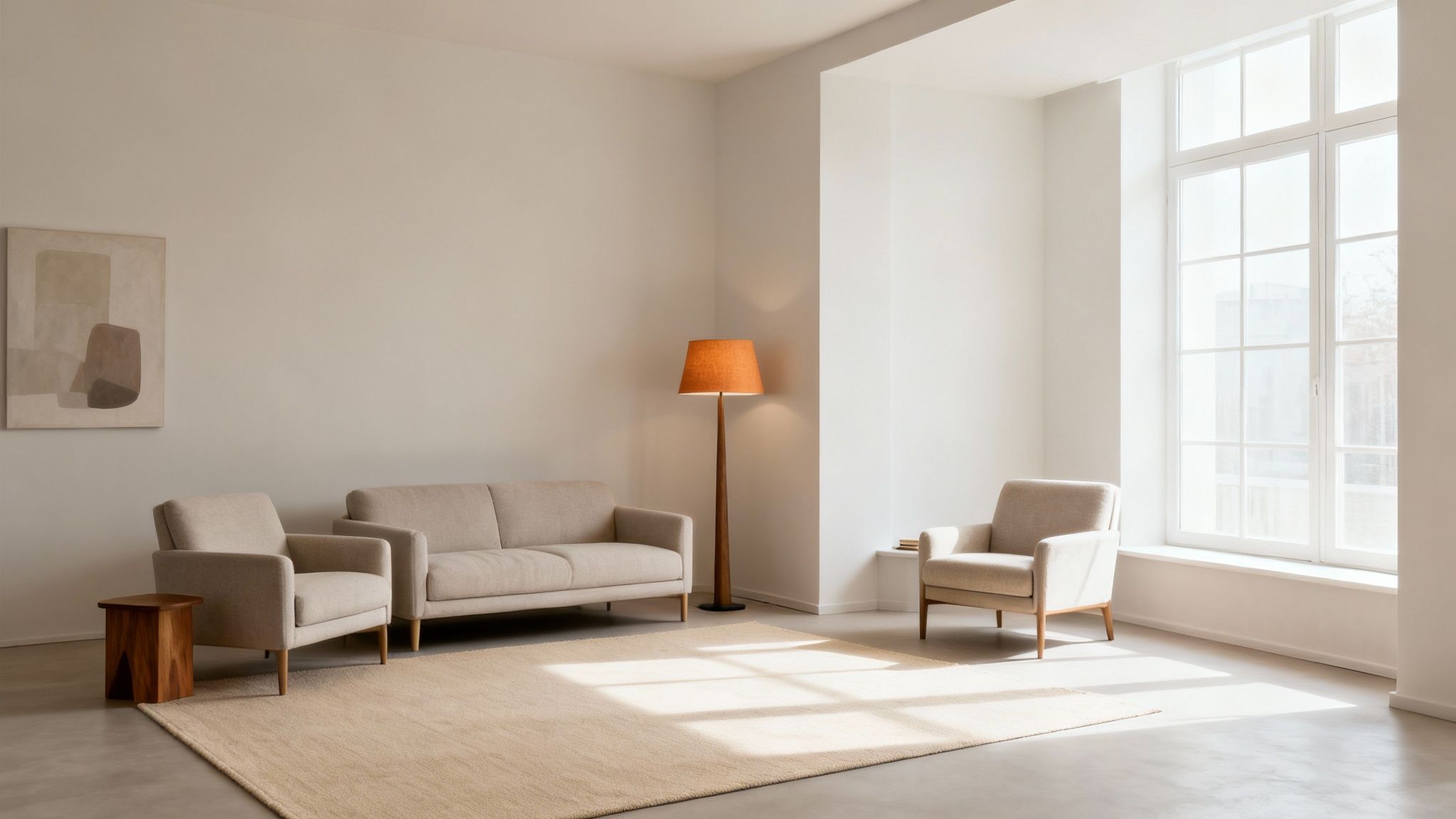
One of the best tricks I've learned for making a living room feel intentional is to create a 'room-within-a-room'. The easiest way to do this? An area rug. It acts as a visual anchor for your main sofa and chairs, instantly defining the primary social space.
When you're figuring out how to arrange your furniture, always think about human interaction first. People need to be able to chat comfortably and move around without bumping into things. I always recommend leaving at least 60cm of clearance between seating and coffee tables to keep the flow easy and natural.
A few pointers I always stick to:
- An 8ft × 10ft rug is a great starting point for most living rooms. Try to position it so at least the front legs of all your main seating are on it. This is what ties the whole look together.
- Stick to that 60cm (about 2ft) rule for main walkways. Anything less and people start shuffling sideways.
- Keep seating no more than 240cm apart. This ensures you can hold a conversation without having to raise your voice.
To really make the space pop, think about the rug's pattern. A bold geometric design will draw the eye straight to the centre of your conversation zone, making a strong statement. If you prefer something more understated, a subtle, tone-on-tone pattern lets the shapes of your furniture take the spotlight. Either way, the rug sends a clear signal to guests, inviting them to come in and relax.
Arranging Seating for Natural Interaction
My first piece of advice is nearly always the same: pull your furniture away from the walls! Even floating the sofa just a few inches inward can make a huge difference, turning a big, open room into a much cosier, more intimate space.
A classic, foolproof arrangement involves pairing your main sofa with two chairs angled slightly towards each other, at about 30°. This creates a natural conversational triangle that feels both balanced and welcoming.
The goal is to encourage eye contact and easy conversation. A good rule of thumb is to keep people close enough to chat comfortably—roughly an arm’s length plus a coffee table away.
Here’s a quick breakdown of common arrangements I use:
Grouping your seating like this doesn't just improve conversation; it also helps keep secondary pathways clear. It makes it much easier to place side tables, too, ensuring everyone has a convenient spot for their drink or a book.
Turning Awkward Corners into Functional Spaces
Those empty, forgotten corners are pure potential. Don't let them go to waste! Think of them as mini-rooms just waiting for a purpose. You could create a perfect reading spot with a plush armchair, a tall floor lamp arching over it, and a small side table.
Or, if you need a workspace, a slim, wall-mounted desk that folds away is a brilliant solution. It gives you the function you need during the day without cluttering up your relaxation space in the evening.
It's clear that modern UK homes need to be both stylish and incredibly practical. With over 33% of UK households having just one or two people, furniture needs to be smarter and more adaptable. We're seeing a huge demand for things like modular sofas and foldaway tables. In fact, a recent report from Statista found that nearly 45% of buyers are now looking for sofas with built-in storage or convertible features.
Transforming an unused corner is simpler than you think:
- Measure the space first. This ensures you choose furniture that’s the right scale and won't overwhelm the nook.
- Look for multi-purpose pieces. A storage ottoman, a bench with hidden compartments, or a folding desk can be a game-changer.
- Define the zone. Add dedicated lighting (like a spotlight or floor lamp) and a few personal accessories to give the nook its own distinct identity.
If you’re working with an open-plan layout, you might also find some great ideas in our guide to combining kitchen and lounge areas. You can check out our guide on open-plan kitchen living for more tips.
This layered approach ensures every square inch of your living room is working for you, creating a space that’s not just beautiful but also brilliantly organised.
Adding Surfaces and Perfecting Your Lighting
Once your main seating is in place, it’s time to bring in the supporting players: the tables and lights that make a room truly liveable. This is where a collection of furniture starts to feel like a cohesive, functional living room. Getting these details right is the secret to a space that works for you every single day.

Let's start with the coffee table. One of the most common mistakes I see is placing it too far from the sofa. This forces everyone to do that awkward forward-lunge just to put down a mug. It instantly makes the space feel less comfortable.
As a rule of thumb, aim for a gap of 35cm to 45cm (about 14-18 inches) between the edge of your sofa and your coffee table. It's the sweet spot—close enough to be useful, but with plenty of legroom.
Side tables are next, and they absolutely shouldn't be an afterthought. For a really clean, seamless look, try to match their height to the arm of your sofa or armchair, or just a touch lower. This avoids jarring visual lines and makes them far more practical for everyday use.
The Three Essential Layers of Lighting
Lighting can make or break a room, yet it’s so often overlooked. Relying on a single, harsh ceiling light is a surefire way to make a space feel flat and clinical. A much better approach is to think in layers.
- Ambient Light: This is your foundation—the overall illumination for the room. It usually comes from a central pendant, chandelier, or perhaps some recessed spotlights.
- Task Light: This is all about function. Think of a focused floor lamp angled over your favourite armchair for reading, or a beautiful table lamp on a console for sorting keys and post.
- Accent Light: This is where you add the drama and personality. It’s the light that draws attention to the things you love, like a picture light illuminating a piece of art or an uplighter tucked behind a large plant to create captivating shadows.
When you combine these three layers, you gain complete control over the room's atmosphere. You can dial it up for a lively gathering or dim it all down for a cosy film night. For more inspiration, take a look at our guide to choosing the perfect decorative light bulbs.
This thoughtful, integrated approach is becoming more popular than ever. In fact, smart furniture is projected to see a 30% sales increase between 2023 and 2025, with pieces featuring built-in lighting and charging ports leading the way. While over 35% of furniture sales now happen online and 55% of shoppers use 3D planning tools, it's clear people still crave real-world advice; 65% of consumers still value getting in-store guidance on arranging their spaces.
By carefully layering your surfaces and lighting, you’re not just arranging furniture—you’re creating a beautifully lit, welcoming, and practical heart for your home.
Adding Personality With Art And Accessories
Once your seating and tables are laid out just right, the fun begins. This is the layer where your living room transforms from functional to utterly you. It’s not about crowding every surface but curating pieces that speak to your taste and lifestyle.
I’ve seen clients light up when a treasured object finally finds its home—and you will too. By styling with intention, you ensure each item has a role: whether it’s to spark conversation, add a splash of colour or simply bring you joy every time you walk in.
Using Art And Mirrors To Enhance Your Layout
Wall art ties a room together—but only if it’s hung thoughtfully. A mistake I often spot is artwork floating too high, leaving that awkward gap above sofas or consoles.
Design pros aim for an artwork’s centre at 145-152cm from the floor. When it hovers above a sofa, leave around 15-20cm between the back of the sofa and the piece.
Mirrors deserve a special mention. Position one opposite a window to ricochet daylight across the space—suddenly, a snug room looks grander. In narrow layouts, this trick is a game-changer.
For creative ways to arrange multiple frames, explore these inspiring gallery wall ideas. You’ll find plenty of real-life setups to spark your own gallery.
Layering Textiles For Colour And Comfort
Textiles are your secret weapon for instant warmth and personality. They’re an easy way to inject pattern or hue without overhauling your furniture.
- Cushions: Aim for odd numbers—three or five cushions feels effortlessly modern. Mix shapes and materials for visual interest.
- Throws: A casually draped throw adds softness and introduces a fresh accent colour. I often switch mine out seasonally.
- Curtains: Hang them high and wide—well beyond the window frame—to make ceilings feel taller and windows grander.
Pull back occasionally and edit. Too many fabrics can look cluttered, so keep the palette cohesive. Once you’ve layered these finishing touches, your living room will tell a story that’s unmistakably yours.
Common Living Room Layout Conundrums
Even the best-laid plans can hit a snag. Every living room has its own quirks, from awkward corners to less-than-ideal proportions. I've seen it all, and certain challenges crop up again and again.
Let's walk through some of the most common layout puzzles and find some practical solutions. The trick isn't just knowing the rules of furniture arrangement; it's knowing how to adapt them to make a tricky space feel intentional and inviting.
What’s the Best Layout for a Long, Narrow Room?
With a long, skinny room, the biggest temptation is to push all the furniture up against the walls. Don't do it! This creates a "bowling alley" effect that feels sterile and impersonal. The real secret here is to divide and conquer.
Think about breaking the room up into smaller, distinct zones. Your main conversation area—maybe a sofa facing a pair of armchairs on a large rug—can occupy the centre of the room. This immediately gives the space a sense of purpose and leaves the ends free for other things.
- One end could transform into a quiet reading nook with just a single cosy chair, a small side table, and a good lamp.
- The other could be perfect for a slim console table or a small desk for catching up on emails.
By creating multiple "destinations," you interrupt that long, straight line of sight. It makes the room feel so much more balanced and actually encourages you to use the entire space.
How Do I Arrange Furniture Around a Corner Fireplace?
A corner fireplace can feel like a design headache, but it’s actually a brilliant built-in focal point. The key is to stop fighting it. Instead of forcing everything to be parallel to the walls, angle your main seating group towards the fireplace.
Try placing your biggest piece, usually the sofa, on the longest wall opposite the hearth. Then, you can flank it with two armchairs angled in, forming a conversational triangle that naturally faces the fire. This approach makes the whole room feel cohesive and instantly cosier.
Here's a pro tip: place an area rug on the same diagonal as your seating. This single move is a game-changer. It visually anchors the entire arrangement and makes that once-awkward corner feel completely deliberate and stylish.
What if a Main Walkway Cuts Through the Room?
When a major traffic path slices right through your living room, it can feel like you’re designing in a hallway. Trying to force one big seating area around it just doesn't work. The best approach is to stop fighting the flow and create two distinct, smaller zones.
Think of it as creating a "floating" walkway right through the middle. On one side, you can set up your main seating area with a sofa and coffee table. On the other side of the path, you might place a pair of armchairs with a small table between them, creating a perfect spot for a quiet chat or a morning coffee.
Using matching area rugs in both zones is a great way to tie the two spaces together visually, even though they're physically separate. This strategy respects the natural flow of traffic while making sure every square foot of the room feels both comfortable and functional.

